the media and politics
1/51
There's no tags or description
Looks like no tags are added yet.
Name | Mastery | Learn | Test | Matching | Spaced |
|---|
No study sessions yet.
52 Terms
What is the principle-agent problem of democracy?
distance between the people and the representatives
lack of observability
potential for mis-rule
What is the solution to the principle-agent problem of democracy?
media as a necessary part of a democratic system
What is the ideal role of the media in society?
Structural functionalism is the ideal role
According to Diceman, what is the structural functionalism?
The Norm is, “within our large and dispersed liberal democratic society, the media is supposed to play an important communications role:
facilitating public discourse
informing the public
representing the public and
acting as a watchdog of the power structures that effect public’s wellbeing.
What is the expression of structural functionalism?
The ‘free press’
Free speech
Access to public information
What is the public service media model? And how does it serve public interest?
It acts as a proxy for serving the public and focusing on important issues.
public interest focus: news, educational, cultural content
independence from political and commercial pressures
universal access - all citizens should be able to access media
publicly funded to ensure viability
accountability and transparency key to mission
What is the liberal market/market media model?
‘Power without responsibility - the prerogative of the harlot throughout the ages’
Commercial media provides for:
the financing of news production
private not public funding
the regulation of news production and innovation in news production
supply and demand
‘telegraphing’ the popular will to elites
ratings/sales/circulation figures
the ultimate purpose is not public interest but profit.
The media as a source of market correction - what is published and becomes popular is a reflection of society, indicating to politicians.
What is the fox media model?
Poltiical news as entertainment
blurring of news and entertainment (sensationalisation)
profit driven model microviewership driver
drives polarisation
opinion polling is at the forefront of policy.
How does the media influence politics?
Plato’s allegory of the cave:
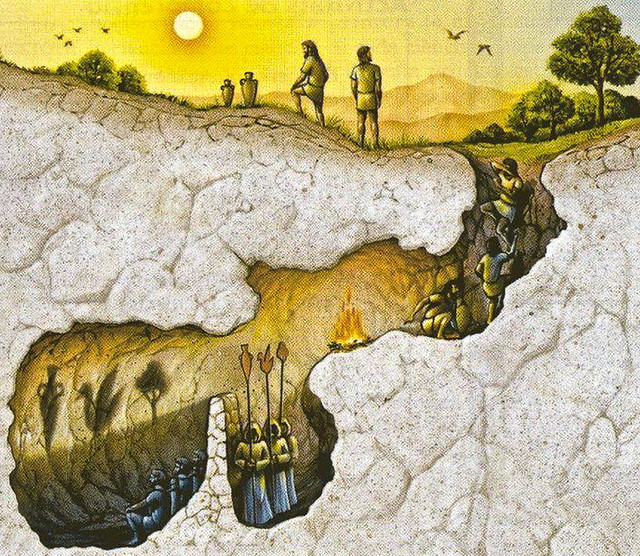
What is the ‘mean world syndrome’ of Gerbner and Gross’ cultivation theory in realtion to the media?
The media is powerful, and people are suggestible.
The media is pervasive, concentrated and with increasing levels of consumption. The cultivation theory of Gerbner and Gross: prolonged exposure to TV violence creates afear of crime and a ‘mean world’ syndrome.
What do Romer et al argue on the power of the news?
Fear is largely independent of local crime rates.
‘Across a wide spectrum of the population and independent of crime rates, viewing local television news is related to increased fear of and concern about crime’.
How does the media effect politics? two categories:
shaping what’s covered: agenda setting
shaping the wider context of interpretation
“the press may not be successful most of the time in telling people what to think, it is stunningly successful in telling its readers what to think about” -Bran and Davis 2010.
What is the role of agenda setting (shaping what gets covered) role in the media/effecting politics?
“collection of problems, understanding of causes, symbols, solutions, and other elements of public problems to come to the attention of members of the public and their governmental officials” -Birlklend, 2015
What is the role of shaping the wider context of interpretation in the media/its role in shaping politics?
The media’s epistemological role in shaping culture, “mass media create common reality by shaping the conceptual environment in which humans communicate… political reality is formed by mass communication reports which are talked about, altered, and interpreted by citizens in society. The totality of this process constitutes reality”. (Braus and Davis)
In the Iraq War, what was an example of agenda setting?
Agenda-Setting: The Iraq War
◦ History primer: US + Western coalition invades Iraq in 2003 based on a series of fabrications:
◦ Claim: Saddam Hussain had weapons of mass destruction (False – but 22% still believed this in 2005)
◦ Claim: Saddam Hussain was involved in planning 9/11 (False – but 49% still believed this in 2005)
◦ Claim: western forces would bring freedom and democracy to Iraq (False – see ISIS)
◦ Western media largely uncritical of the war – of Rupert Murdoch’s 175 papers, 174 initially took editorial lines supportive of the war (Hobart Mercury later brought into line
too)
◦ See also Jeff Bezos and the Washington Post
What is an example of the media shaping the wider context of what is believed and what makes the news?
the Nord Stream Pipeline Bombing 2022
the stream is built and owned by the Russian state to transport gas to Germany. Pipeline was sabotged by undersea explosions of 2022, press original blamed Russia, dissenting voices portrayed as conspiracy theorists/pro-Russia, demands for UN investigation blocked by US
US journalist Hersh alleged US involvement, US ships were there at the time. Story was ignored, then narrative shifted to blame Ukrainians.
A third way, more underlying of how the media effects politics is through:
framing -shaping the meaning and interpretation of what is covered in the media
What exactly is framing in the media? According to R Entman?
“To frame is to select some aspects of a perceived reality and make them more salient in a communicating text, in such a way to promote a particular problem definition, causal interpretation, moral evaluation or treatment recomendation”
What are some examples of framing in the media?
Tax relief vs tax cuts
Same sex marriage vs marriage equality
underpayment vs wage theft
Pro-life vs pro-forced birth
What are some broad characterizations of frames?
◦ Organising principles
◦ Idea used to structure a news story
◦ Narratives (and narrativisation)
◦ “If-then”, “thus-therefore”
◦ Cues: labels and categories
◦ Word or phrase
◦ Rhetorical value
cues: labels and categories -
word or phrase
rhetorical value
What are the structural causes of framing?
the nature of the medium: no images, no TV. ‘Soundible’ politics
The mode of production: capitalism and commercialism, what sells. Keeping people in the buying mood
What the audience will accept
How does media control work in non-democracies?
complete control over media production
highlighting or fabricating the government’s achievements
framing the coverage of negative events in a way that shows the government’s intention and capacity in securing good governance
completely censoring coverage that may damage the government’s image
promoting poltiical discourse and ideologies that help justify and defend the regime
What are some features of media control in Russia today?
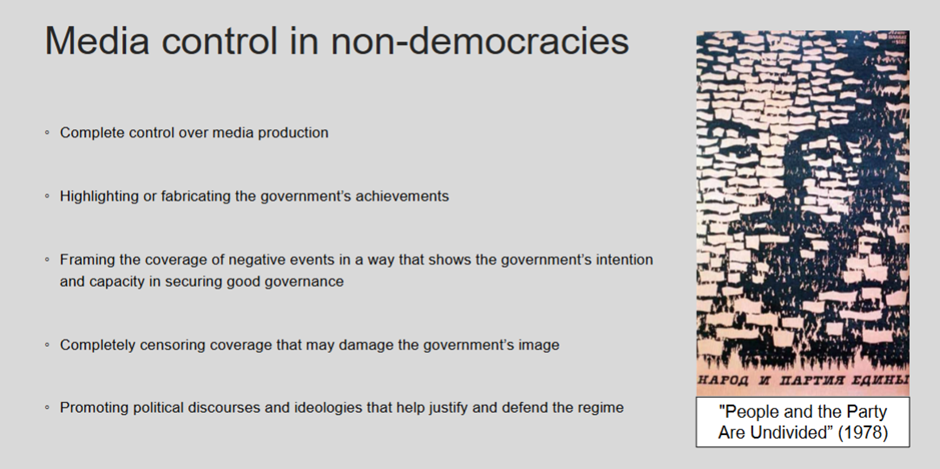
According to Crozier, what is the recursive governance theory?
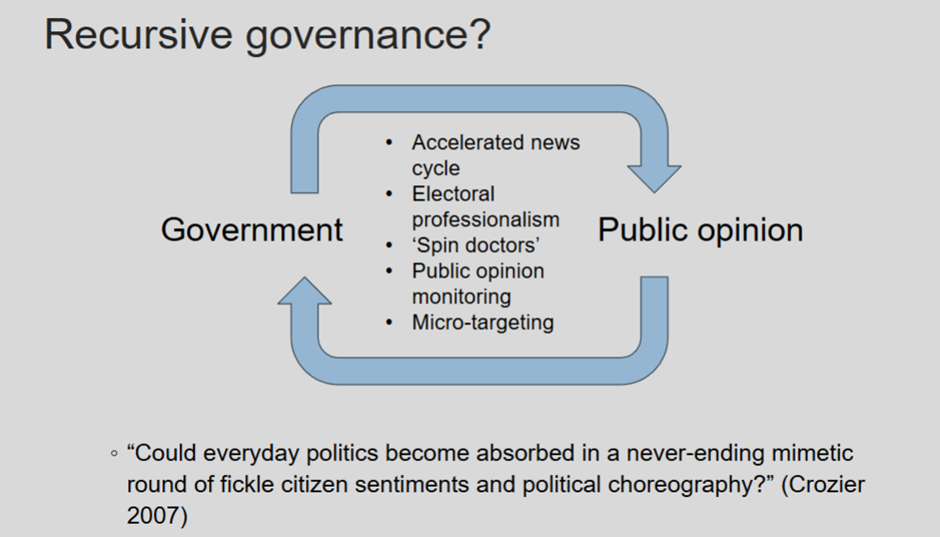
What are some characteristics of new media (digital and social media?)
Plasticity
Interactivity
Disintermediation/reintermediation
Hidden characteristics and capabilities
According to Benkler, what are the ideas of new media as democratising?
the internet allows all citizens to change the relationship to the public sphere. They no longer need to be consumers and passive spectators. they can become creators and primary subjects.
0> new media as a new ‘public sphere’
What is the role of media as an equaliser -Negroponte?
New political parties and movements (eg #metoo, #blacklivesmatter)
What are the cornerstones of the negative views of new media?
New media dystopias:
The economic crises of news production (loss of journalists, independent media companies)
privacy concerns (relationship with the surveillance state, rise of surveillance capitalism)
Doomscrolling -Park 2015
The epistemological crisis (misinformation as hybrid warfare, algorithms, filter bubbles and political subculture formation)
What is the hostile media effect?
People with pre-existing opinions believe news reports are biased against their own opinions, irrespective of how objective and balanced these reports might be
Measure of bias would require objective standard against which we can compare existing media
What are the areas of debate for claim ‘left wing media bias’ vs ‘right wing media bias’?
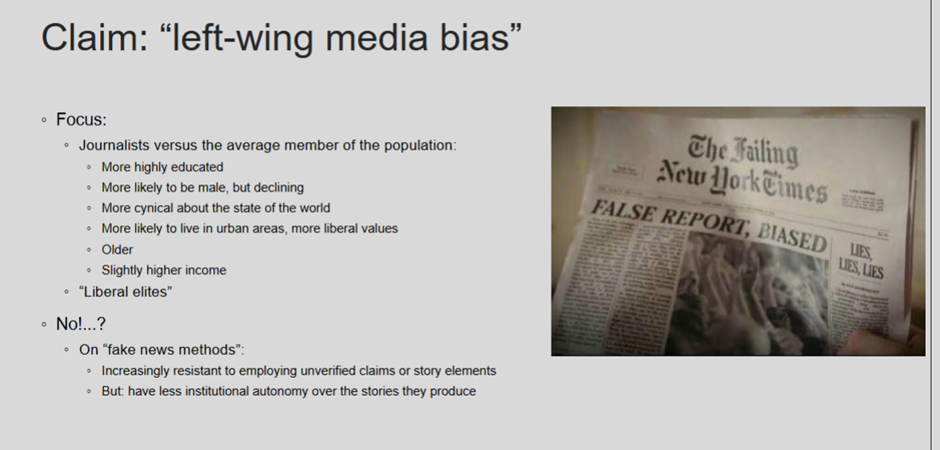
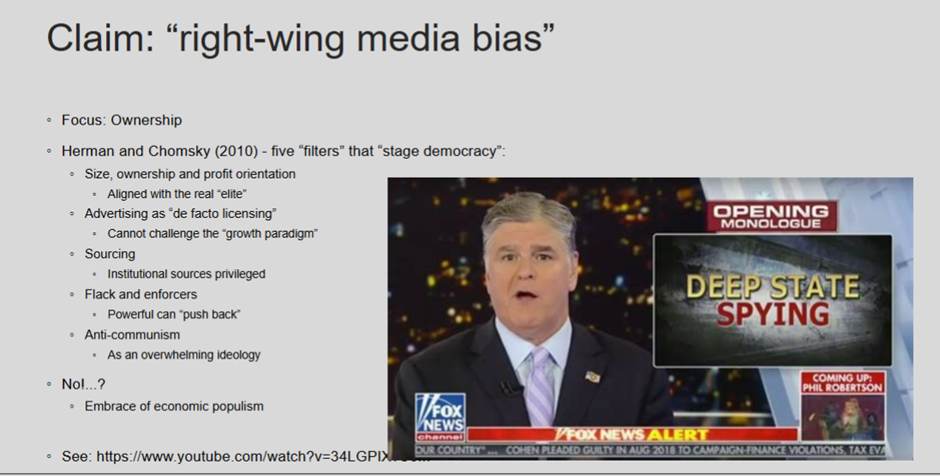
What does media ownership look like in Australia?
Two groups own nearly ¾ of our media - very concentrated and limited voices
What occured in the murdoch royal commission?
Murdoch Royal Commission?
◦ Previous attempts at limiting ownership abandoned by Labor
◦ Latest reform was repeal of 2/3 rule àallows further concentration of media ownership
◦ In electoral terms, print media has overwhelmingly favoured Coalition/LNP in past decades
◦ But remember what we said about the power/influence of media
◦ Agenda-setting power?
What is ‘post-truth’?
A situation ‘relating to or denoting circumstances in which objective facts are less influential in shaping public opinion than appeals to emotion and personal belief’
What is disinformation?
Deliberately spreading false information
What is misinformation?
Unintentionally spreading false information
What is malinformation?
Spreading information that stems from truth but is exaggerated in such a way to deliberately cause harm
What is the narrative of post truth era: and how is it similar and linked to populism?
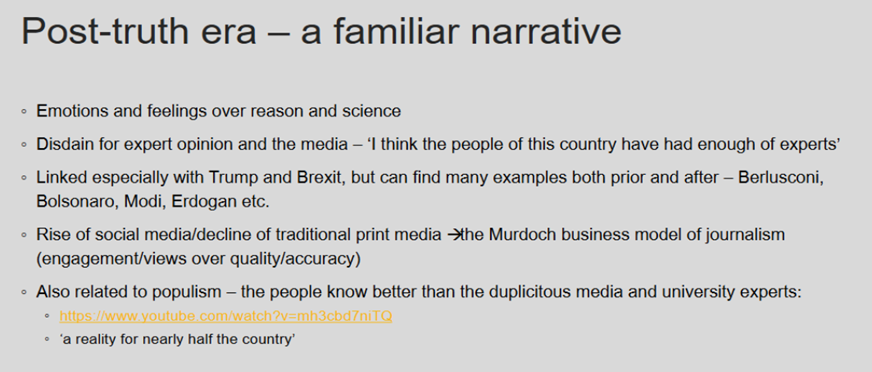
What is an area of debate or area where misinformation is prominent in the media?
PANDEMIC: required high levels of citizens trust in scientific advice - but trust has broken down. ‘Trust the science’ but who is the science?
Competing ideas of scientists - problematic in public discourse
What can be done in the era of misinformation?
More presses/more freedom of speech
Active citizenry
Media literacy
Contemporary views
media oversight
professional norms and autonomy
censorship
content moderation
subsidisation
What does professor doris graber say about false political claims?
“citizens can be protected from false advertising of consumer goods through truth in advertising laws, but there is no way in which they can be protected from false political claims or improper news selection by media personnell without impairing crucial rights to free speech and a free press”
What does Cronkite have to say about capitalism and culture?
- Capitalist class has a commanding say in how and for whom the wealth of the nation is produced. The imperatives of the private market determine the kinds of jobs available, wages we earn, air we breathe, food we eat and the water we drink.
- Capitalism has no loyalty to anything but itself. Private profitability rather than social need is the determining condition of capital investment. Marx and Engels understood that the state has several functions – it carries out tasks that cannot be performed privately, and tends to be to the common defense of the people
- We do not have a free and independent press
What does Cronkite have to say about what is covered in the media?
- One indication of how the press serves the privileged and powerful is found in its treatment of underprivileged and powerless. The poor are most likely to receive coverage during Christmas – donations.
- How the press defines and reports on crimes is largely determined by the class and racial background of the victim and victimiser.
- The media create conservative effects by slighting the issues and focusing on candidate issues. “It is not the issues we are asked to judge, it is the nuances of the presentation”.
- Whether a candidate is prominent or an unknown personage is less important in determining media treatment than his or her politics.
- Campaign propaganda usually reinforces public’s preferences rather than altering them. I.e., ‘selective exposure’ and ‘selective attention’.
- Thus, to say that the media is a process of ‘minimal effects’ because it merely reinforces existing views and does not change them is to overlook the fact that it was never intended to change them and was indeed designed to reinforce the dominant orthodoxy.
- If Big Brother came to America, he will not be fearson. He will come with a smile on his face, a quip on his lips, a wave to the crowd and a press that:
o Dutifully reports the suppressive measures he is taking to save the nation from internal chaos and foreign threat
o Gingerly questions whether he will be able to succeed.
According to Cook, what is a major issue in the approach to combatting misinformation?
Traditional media literacy efforts, which gained traction after the 2016 U.S. election, have focused on improving individuals' ability to discern credible information. However, these approaches often reduce complex issues to binary "fact vs. falsehood" judgments, which fail to address the broader media ecology and the larger societal context of misinformation. Many media literacy programs still focus on individual responsibility, neglecting the roles of communities, institutions, and technology developers.
According to Cook, what is the issue with fact-checking?
Moreover, fact-checking and debunking strategies are limited in their scope. They often provide simplistic solutions to complex issues, isolating misinformation from its broader context. In a postdigital world, where digital media is ubiquitous and continuously influencing how we perceive the world, fact-checking efforts fail to address the complexity and interconnectedness of misinformation.
The traditional educational approach—focused on fact-checking, debunking, and identifying sources—does not adequately prepare students for the complexities of the digital age. A more holistic, meta-disciplinary framework is necessary to navigate the complexities of the postdigital media landscape and address the full range of misinformation challenges.
What does Zuckerman have to say about fake news?
"One of the problems with 'fake news' is how it is used as a stand in ‘that spans everything from false balance...to dezinformatsiya.’” — Zuckerman (2017)
and according to boyd, what issue does this cause? “The real problem... was not so much the blatant ‘fake news’-as-disinformation but factually true content presented in a biased or mis-framed way."“
According to Cook, why is the term ‘fake news’ dangerous?
it has become a weaponised term used by politicians to delegitimise criticism. : "No, I’m not going to give you a question. You’re fake news." — Trump to Jim Acosta during a 2017 White House media event.
What is ‘informaiton disorder’ according to Cook?
introduced as a more comprehensive term to describe the problems of misinformation, disinformation, and malinformation, offering a clearer framework for understanding the broader issues in information environments.
Quote: "Information disorder provides a clearer, more complex, and more useful framework for diagnosing our current disease with our information environments."
According to Cook, what are the three different types of information disorder?
1. Disinformation: False information created with the intention to harm.
2. Misinformation: False information not intended to cause harm.
3. Mal-information: Information based on truth, but used with the intent to harm.
Quote: "Disinformation occupies the intersection of falseness and harmful intent."
According to Cook, what are the three key elements in the process of information disorder?
1. The Agent: Who created, produced, and distributed the information?
2. The Message: What is the content, format, and distinguishing characteristics of the message?
3. The Interpreter: How did the recipient interpret the message, and what actions did they take in response?
According to Cook, what are the three phases of information disorder?
1. Creation: The origin of the message.
2. Production: The message becomes a media product.
3. Distribution: The message is shared or made public.
Quote: "The phases of information disorder are creation, production, and distribution." — Wardle & Derakhshan (2017)
What is a key example of how memetic frames enable misinformation?
Deep memetic frames are critical to understanding the proliferation of misinformation, as they shape cultural narratives, fears, and myths. For instance, the Satanic Panic was fueled by subversion myths, fear of internal enemies, and myths like blood libels and the Illuminati. These were magnified by shifts in the media landscape—what Phillips and Milner term network climate change.
The rise of technologies like home video cameras, photocopiers, and the internet coincided with the creation of new media ecosystems, such as the professionalization of Evangelical media and the rise of the New Right in US politics, which all contributed to spreading misinformation.
(recurrent cultural themes and narratives—play a significant role in shaping and spreading misinformation, both in historical events like the Satanic Panic and modern political crises like the 2016 election.)
What does Zimdars (2020) argue is a good response to disemination of misinformation?
Zimdars (2020) argues that instead of focusing on fact-checking, we should practice frame-checking. Frame-checking involves understanding how information is framed, why it's framed in particular ways, and the emotions or values it invokes. This approach considers the broader systems and motivations behind the spread of misinformation, and it encourages a more nuanced understanding of how beliefs are shaped culturally and technologically.